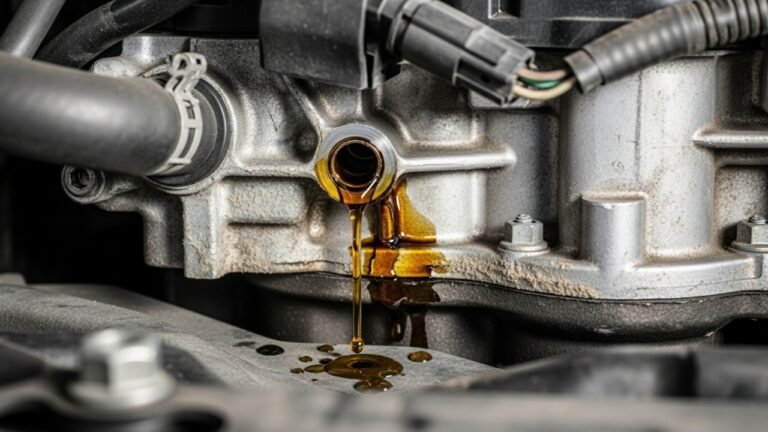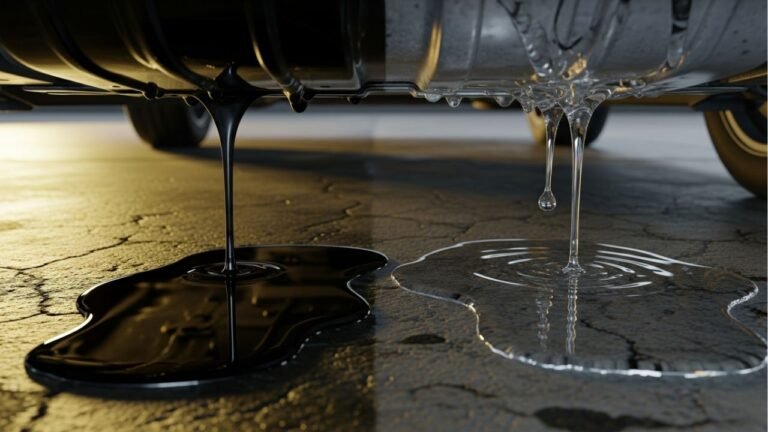Understanding the Effects of Low Oil Level in Car

You’re cruising down the highway, windows down, music up. The road ahead is clear. Everything feels perfect—until your engine makes a strange noise. You ignore it. Later, the dreaded oil light flickers on. Still, you think, “I’ll top it off later.” But did you know that driving with low oil level in your car can lead to irreversible engine damage?
I’ve been there. Years ago, I delayed an oil top-up during a long trip. A few hundred kilometers later, my engine was toast. The repair cost more than the car’s value. That painful lesson taught me a lot about how crucial oil is—not just as a fluid, but as the lifeblood of your engine.
In this article, we’ll explore the effects of low oil level in car in simple, engaging language. You’ll learn the signs, dangers, long-term consequences, and what you can do to avoid a costly breakdown.
Why Engine Oil Matters More Than You Think

Here’s what engine oil does:
-
Lubricates engine parts to reduce metal-on-metal contact
-
Cools the engine by carrying heat away from hot spots
-
Cleans out debris and carries it to the oil filter
-
Protects against corrosion inside the engine
So, when the oil level is low, your engine loses its shield and support. Just like a dehydrated athlete, it starts to strain, overheat, and eventually give up.
What Happens When Oil Runs Low?
Low oil might seem harmless at first. But beneath the hood, your engine is struggling to survive. The effects of low oil level in car aren’t always instant—but they build up fast. Here’s a look into what actually happens:
1. Increased Friction Between Engine Parts
Oil is the buffer that prevents metal parts from grinding together. With low oil, that buffer vanishes. Pistons, cylinders, and bearings start to scrape, heat up, and wear down. The result? Noise, overheating, and damage that gets worse every minute.
2. Engine Overheating
Oil not only lubricates, but it also dissipates heat. When there’s not enough oil, the engine runs hotter than usual. This can lead to a blown head gasket, warped engine parts, or complete engine failure.
3. Reduced Fuel Efficiency
Engines running without proper lubrication use more energy to function. That means you’ll burn more fuel just to go the same distance. If you’ve noticed a sudden drop in mileage, check your oil—it might be lower than it should be.
Silent Warning Signs You Shouldn’t Ignore
The scary part? Your car doesn’t always scream when oil is low. Sometimes, it whispers. These subtle signs can be easy to miss—but ignoring them can lead to expensive repairs.
Look out for:
-
Oil warning light on the dashboard
-
Strange engine noises, like ticking or knocking
-
Overheating or steam coming from the hood
-
Poor acceleration or sluggish response
-
Burning smell from the engine bay
If your engine is making weird noises or your car feels “off,” pull over and check your oil level immediately. It takes two minutes and can save you thousands.
Real-Life Damage: The Price of Ignoring Oil Levels
Still wondering if it’s really that serious? Let me share a quick story.
My cousin drove his sedan with the oil light blinking for two weeks. He thought it was just a sensor issue. One morning, while driving to work, the engine locked up completely. It turned out he had no oil left, and the engine seized.
The mechanic’s verdict? Complete engine replacement. Price tag: over $3,000.
That’s the harsh reality of ignoring the effects of low oil level in car. It’s not just about oil—it’s about protecting a complex, high-speed machine that depends on it.
Common Issues Caused by Low Oil Level
Here’s a quick comparison to help visualize how low oil affects different parts of your car:
| Component | Effect of Low Oil | Long-term Impact |
|---|---|---|
| Pistons & Cylinders | Increased friction & wear | Engine failure, power loss |
| Crankshaft Bearings | Poor lubrication | Complete engine seizure |
| Valves & Lifters | Noise, misfiring | Performance issues, fuel inefficiency |
| Oil Pump | Cavitation due to air bubbles | Pump failure, uneven oil distribution |
| Turbocharger (if present) | Overheating, lack of lubrication | Turbo failure, repair costs > $1,000 |
As you can see, low oil doesn’t just affect one part—it hurts the whole engine system.
Bullet Summary: Key Effects of Low Oil Level in Car
To keep it simple, here are the major risks when oil runs low:
-
Parts grind together without protection
-
Heat builds up inside the engine
-
Fuel efficiency drops
-
Engine performance worsens
-
Risk of engine seizure increases
Each of these issues can lead to expensive repairs or even total engine replacement. That’s why checking oil isn’t just routine—it’s a critical act of maintenance.
Cultural Note: Why We Often Delay Oil Checks
In many cultures, especially where public transport is still dominant or car ownership is new, vehicle maintenance is seen as a low priority. We might say, “It’s running fine, I’ll check later.” But the reality is: car engines don’t forgive neglect.
In South Asian households, for example, it’s common to rely on local mechanics or roadside oil changers. While convenient, they often use low-quality oil or skip checks altogether. That’s why regularly checking your own oil level is one of the best habits you can develop as a car owner.
A Friendly Reminder from a Fellow Driver
Think of your engine like your heart. If your blood runs low or dirty, your health suffers. Same goes for your engine with oil. Just a few seconds of checking can save you years of trouble and thousands of dollars.
You don’t need to be a mechanic. Just grab a tissue, pull out the dipstick, and look. If the level is below the mark or the oil looks dirty, it’s time for a change or top-up.
The Long-Term Effects of Repeated Low Oil Levels
One incident might not destroy your engine—but if your oil level runs low repeatedly, the wear adds up silently over time. Just like skipping meals or sleep occasionally won’t hurt you much, doing it every day will wreck your health. Your engine works the same way.
1. Permanent Engine Wear
Even if your engine doesn’t seize, running on low oil slowly wears down the internal parts. Microscopic metal shavings from friction stay suspended in the oil, causing scratches and scarring in the cylinders and pistons. Over time, this damage builds until compression is lost, and your car starts losing power.
2. Reduced Engine Lifespan
A well-maintained engine can last over 200,000 miles. But frequent low-oil events can cut that life in half. Eventually, you’ll face costly rebuilds or replacements, all because of something as simple as skipping regular oil checks.
3. Failing Oil-Dependent Components
Many modern engines include variable valve timing systems, turbochargers, and hydraulic lifters—all of which rely on oil pressure to function. When oil is low, pressure drops. That means these precision systems stop working properly, leading to check engine lights, poor performance, and costly diagnostics.
How to Prevent Low Oil Levels (It’s Easier Than You Think)
Now that we’ve covered the dangers, let’s talk about prevention. The good news? You don’t need to be a mechanic to protect your car. Here’s what you can do:
Check Your Oil Regularly
Every two weeks or before long trips, open your hood, pull out the dipstick, and wipe it clean. Dip it back in and see if the oil is between the minimum and maximum marks. If it’s below, top it up.
Stick to Scheduled Oil Changes
Follow your car’s recommended oil change interval—usually every 3,000 to 7,000 miles depending on the oil type. If you drive in hot, dusty, or stop-and-go conditions, change it more frequently.
Use the Right Oil
Always use the manufacturer-recommended oil grade and quality. Using cheap or incorrect oil can cause sludge buildup, which leads to low oil pressure and more wear.
Fix Leaks Promptly
Oil leaks aren’t just messy—they’re dangerous. If you notice dark stains under your car or a burning oil smell, get it checked. Small leaks can lead to rapid oil loss and engine damage.
Your Car Takes Care of You — Return the Favor
It’s easy to forget how much our cars do for us. They take us to work, carry our families, and get us home safe. But like any relationship, it needs maintenance. Just like we feed our bodies, our engines need oil—not just to survive, but to thrive.
Skipping oil checks is like ignoring a friend’s cry for help. Eventually, they’ll stop functioning. So treat your car with care. It doesn’t ask for much—just a quick peek at the oil level every now and then.
Let’s be honest: we’ve all made mistakes with our cars. Maybe you pushed it a few extra hundred miles. Maybe you skipped that oil change because money was tight. That’s okay. What matters is what you do next.
FAQs: Effects of Low Oil Level in Car
Here are some common questions drivers often ask about oil levels—and straight-to-the-point answers:
1. Can I drive short distances with low oil?
No. Even short trips can cause major damage if oil is too low. Always top up before driving, no matter the distance.
2. How do I know if my oil level is low?
Check the dipstick under the hood. Look for the oil level between the two marks. Warning lights, strange noises, or poor performance are also signs.
3. What happens if I run out of oil completely?
Your engine can seize, meaning it locks up entirely. At that point, you’ll need an engine rebuild or replacement—which is extremely expensive.
4. Will my check engine light turn on if oil is low?
Sometimes. But often, you’ll see a dedicated oil light (usually a red oil can symbol). Don’t rely solely on lights—check manually.
5. Can low oil affect my car’s acceleration?
Yes. Low oil increases friction and heat, making your engine sluggish and reducing responsiveness during acceleration.
6. How often should I check my oil?
Every two weeks is ideal—or at least once a month. Always check before road trips or long drives.
7. Is synthetic oil better at preventing low oil damage?
Synthetic oil resists breakdown and lasts longer under heat and pressure. It’s a better option, especially for high-performance or older engines.
8. What if I overfill the oil trying to fix it?
Too much oil is also harmful. It can foam up and lose its lubricating power. Always stay within the recommended dipstick range.
Final Takeaway: Oil Is a Small Thing With Big Impact
Let’s bring it all home.
The effects of low oil level in car are no joke. From increased friction to full engine failure, low oil can destroy your engine quietly and quickly. But with just a few minutes a month, you can avoid the stress, the cost, and the breakdowns.
Treat your engine like a friend. Check in, keep it nourished, and listen when it complains. You don’t need to be an expert—just a responsible car owner.
The next time you stop for gas or park your car at home, take 60 seconds to pop the hood and pull out that dipstick. Your engine will thank you with years of smooth, quiet, dependable driving.






